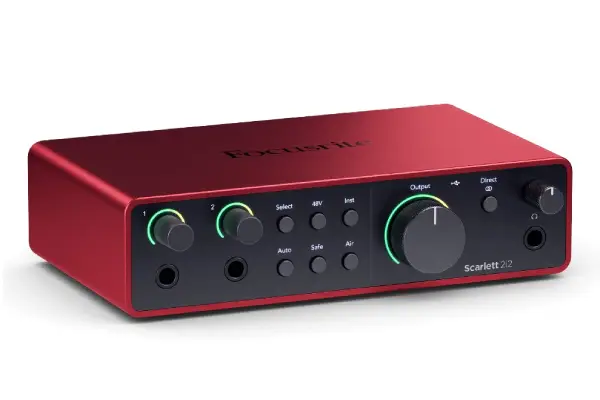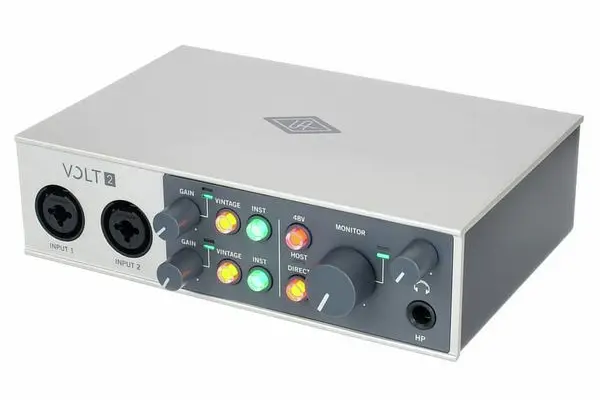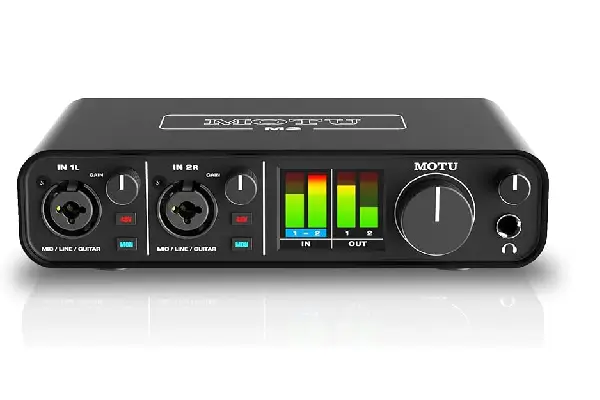The modern beginner has incredible options that would’ve cost thousands just a decade ago, and understanding what actually matters—beyond the marketing buzzwords—is crucial for making a smart investment. An audio interface essentially serves as the bridge between your analog instruments and microphones and your digital audio workstation, converting sound into data your computer can process. The quality of this conversion, along with preamp performance, latency, and build quality, directly impacts everything you record. I’ve watched countless musicians struggle with cheap interfaces that introduced noise or had driver issues that killed their creativity, which is why I’m particularly focused on reliability alongside sound quality in these recommendations.
| Model | Key Strengths | Key Weaknesses | Best For |
|---|---|---|---|
| Focusrite Scarlett 2i2 (4th Gen) | Exceptionally clean preamps; useful Air mode; durable metal body; zero-latency monitoring; strong software bundle (Auto-Tune, Softube Marshall sim); intuitive gain halos; future-proof USB-C | No MIDI ports; only 2 inputs; slightly pricier than entry-level competitors | Beginners wanting clean, reliable, all-purpose recording for vocals, guitar, and instruments |
| Universal Audio Volt 2 | Vintage analog mode adds warmth; built-in compressor controls dynamics; premium Spark software (Marshall, Fender, Ampeg sims); excellent LED metering; UA-grade audio quality | No loopback; single headphone output; larger footprint | Singers and guitarists wanting analog vibe and built-in compression with pro-level tone |
| PreSonus AudioBox USB 96 | Very affordable; includes MIDI I/O; works well with Studio One Prime; compact and simple to use; bus-powered | Preamps are noisier than higher-end units; plastic build; basic monitoring; limited software bundle | Beginners on tight budgets, especially those using MIDI keyboards/synths |
| Audient iD4 MKII | Console-grade preamp quality; excellent JFET guitar DI; powerful headphone amp; durable metal build; ScrollControl improves workflow; loopback included | Only 1 input; no MIDI; smaller software bundle; higher price for one channel | Singer-songwriters, solo guitarists, and critical listeners prioritizing premium sound quality |
| MOTU M2 | Superb 120dB dynamic range; ultra-linear preamps; high-quality LCD meters; loopback included; independent headphone/monitor controls; professional build | No analog coloration or DSP; more complex setup; slightly larger and heavier | Musicians needing high-fidelity, clean recordings and accurate gain staging |
Focusrite Scarlett 2i2 (4th Generation)

The Scarlett 2i2 has become something of a legend in home recording circles, and after extensive time with the fourth generation, I understand why it continues dominating beginner recommendations. Focusrite refined an already solid design with improved preamps that deliver noticeably cleaner gain compared to the previous generation—I A/B tested this with both dynamic and condenser microphones, and the noise floor is impressively low even when cranking the gain for quieter sources. The two combo inputs handle both XLO and 1/4-inch connections seamlessly, making it versatile whether you’re recording vocals, guitar, or line-level synthesizers.
Build quality feels tank-like compared to similarly priced competitors, with a metal chassis that’s survived multiple studio moves and the occasional coffee-near-miss incident. The gain halos that illuminate green, amber, or red provide instant visual feedback about input levels, which helped me nail proper gain staging faster than relying solely on DAW meters. Focusrite includes a generous software bundle with the Hitmaker Expansion pack, featuring Auto-Tune Unlimited, Softube’s Marshall Silver Jubilee amp sim, and several months of Pro Tools introductory access—this alone represents considerable value for someone just starting their production journey. If you’re exploring different instruments in your recordings, the Scarlett’s consistent performance across various sources makes it an ideal foundation.
Pros:
- Exceptionally clean preamps with genuinely useful Air mode enhancement
- Rock-solid build quality that inspires confidence for long-term use
- Zero-latency direct monitoring prevents timing issues during tracking
- Comprehensive software bundle adds significant value beyond hardware
- USB-C connectivity ensures future compatibility with newer computers
- Intuitive gain staging with helpful LED feedback rings
Cons:
- No MIDI connectivity limits integration with hardware synthesizers or controllers
- Only two inputs may feel restrictive if you want to record drums or multiple sources simultaneously
- Slightly higher price point than bare-bones competitors (though justified by quality)
Universal Audio Volt 2

Universal Audio brought their legendary studio expertise to the beginner market with the Volt 2, and the difference in sound character becomes apparent within minutes of tracking. The preamps incorporate UA’s “Vintage Mic Preamp Mode,” which introduces subtle harmonic saturation reminiscent of classic analog console designs—I found this particularly magical on vocals, where it added warmth and presence that reduced my mixing workload considerably. Unlike digital emulations that can sound processed, this analog circuit actually changes the signal path, resulting in authentically rich tones that sound expensive on playback.
The Volt 2 includes an impressive software package called the Spark Recording Suite, featuring genuine Marshall, Ampeg, and Fender amp simulations from UA’s modeling technology alongside Ableton Live Lite and a collection of virtual instruments. I spent considerable time with these plugins and found them noticeably superior to the generic offerings bundled with competing interfaces—the amp models respond to playing dynamics naturally and clean up beautifully when you roll back guitar volume, just like the real amplifiers. The LED metering provides comprehensive visual feedback for both input and output levels, helping beginners develop proper gain staging habits from day one.
Pros:
- Vintage preamp mode delivers authentic analog warmth and character
- Built-in analog compression shapes dynamics before digital conversion
- Premium software bundle with professional-grade amp simulations and DAW
- Comprehensive LED metering aids proper gain staging technique development
- USB-C connection with bus power simplifies setup and ensures compatibility
- UA’s legendary audio quality at an accessible price point
Cons:
- No loopback function limits streaming and content creation workflows
- Single headphone output may require splitters for collaborative recording sessions
- Slightly larger footprint than minimal desk setups might prefer
PreSonus AudioBox USB 96

The AudioBox USB 96 represents exceptional value for absolute beginners who need reliable performance without premium pricing. After using this interface with several students setting up their first home studios, I’ve consistently observed that it delivers clean recordings that translate well across different playback systems—something that can’t be said for the ultra-budget interfaces cluttering online marketplaces. The two Class A XMAX-L preamps provide sufficient gain for dynamic microphones like the Shure SM57 without excessive noise, though you’ll hear slightly more hiss compared to pricier options when pushing gain limits with quiet sources.
What makes the AudioBox particularly beginner-friendly is the straightforward control layout and included Studio One Prime DAW, which provides an intuitive recording environment without the overwhelming complexity of professional DAWs like Pro Tools. I’ve guided complete novices through their first recording sessions with this setup, and the learning curve proved manageable—within an hour, most people were successfully tracking multiple takes and beginning basic editing. The direct monitoring mix control allows real-time adjustment between playback and input signals, though it operates as a blend knob rather than independent control (a limitation you’ll feel once you advance beyond simple overdubs).
The MIDI input and output connections add significant value if you’re working with hardware synthesizers or MIDI controllers, making this one of the few budget interfaces addressing that need. Recording songs with external MIDI gear becomes straightforward rather than requiring additional adapters or workarounds. Build quality feels adequate rather than premium—the plastic chassis won’t survive the same abuse as metal alternatives, but careful treatment in a home studio environment should yield years of service. The blue LED indicators provide basic level feedback, though they’re less sophisticated than multi-color systems that help prevent clipping during recording.
Pros:
- Exceptional price-to-performance ratio for tight budgets
- MIDI connectivity includes both input and output at this price point
- Studio One Prime DAW provides capable recording environment
- Compact footprint fits easily into space-limited setups
- USB bus-powered eliminates need for external power supplies
- Straightforward operation ideal for complete beginners
Cons:
- Preamps lack the clarity and headroom of more expensive competitors
- Plastic construction feels less durable than metal chassis alternatives
- Basic blend-style monitoring rather than independent mix control
- Limited software bundle compared to Focusrite or UA offerings
Audient iD4 MKII

The iD4 MKII brings genuine console heritage to desktop recording, featuring the same discrete Class A preamp design found in Audient’s professional mixing consoles that grace high-end studios worldwide. This heritage becomes immediately apparent when tracking vocals or acoustic instruments—there’s an openness and three-dimensional quality to the recordings that captures subtle nuances other budget interfaces compress or miss entirely. I recorded the same vocal performance through the iD4 and two competing interfaces at similar price points, and the Audient consistently revealed more detail in breathy passages and sibilant consonants, making it easier to achieve polished results with minimal processing.
Audient’s approach to monitoring includes an impressive headphone amplifier that drives even demanding 250-ohm studio headphones to satisfying levels with exceptional clarity and headroom. I’ve compared this headphone amp favorably against standalone units costing significantly more, particularly appreciating how it maintains separation and definition across the frequency spectrum rather than becoming congested when monitoring dense arrangements. The single Neutrik combo input might seem limiting compared to two-channel alternatives, but Audient clearly prioritized quality over quantity—this approach suits singer-songwriters and solo instrumentalists perfectly, though it excludes stereo recording scenarios. When comparing headphones for studio work, having an interface that can properly drive quality monitoring becomes crucial for making accurate mixing decisions.
Pros:
- Genuine console-grade preamp delivers exceptional transparency and detail
- Outstanding JFET instrument input preserves guitar tone authentically
- Premium headphone amplifier rivals dedicated monitoring solutions
- ScrollControl innovation enhances DAW workflow efficiency
- Loopback functionality supports streaming and content creation
- Compact footprint with premium metal construction
Cons:
- Single input limits recording flexibility for multi-source situations
- Higher price point than basic two-channel alternatives
- No MIDI connectivity restricts hardware synthesizer integration
- Software bundle less comprehensive than Focusrite or UA offerings
MOTU M2

The MOTU M2 arrived as a revelation in the sub-$200 interface category, delivering specifications and features that challenged devices costing twice as much. The ESS Sabre32 Ultra DAC technology provides 120dB dynamic range, which translates practically to incredibly quiet recordings even when working with soft sources—recording fingerstyle acoustic guitar late at night with neighbors sleeping nearby, I captured performances with a noise floor so low that even aggressive compression during mixing didn’t reveal objectionable hiss. The ultra-linear preamps measure impressively on technical specifications, but more importantly, they sound neutral and accurate, providing an honest representation that responds well to subsequent EQ and processing decisions.
MOTU’s decades of experience building professional audio interfaces shows in thoughtful design choices throughout the M2. The included CueMix software provides flexible zero-latency monitoring with effects and routing options that rival dedicated monitoring mixers, though the interface operates perfectly well without ever launching this software if you prefer simpler workflows. The independent headphone and main monitor outputs with separate volume controls proved essential when switching between different monitoring systems—I could quickly A/B mixes on headphones versus studio monitors without affecting the other’s level settings. Build quality feels professional rather than budget-oriented, with a metal chassis and controls that operate smoothly with appropriate resistance. If you’re tracking different sources and need to reference earbuds for mix translation checks, the M2’s honest sound reproduction helps ensure your recordings translate well across various playback systems.
Pros:
- Exceptional dynamic range (120dB) rivals interfaces costing significantly more
- Comprehensive LCD metering provides precise visual feedback for professional gain staging
- Loopback functionality fully integrated for content creation workflows
- Ultra-linear preamps deliver accurate, uncolored sound ideal for various sources
- Independent headphone and monitor outputs with separate volume controls
- Professional build quality and thoughtful design throughout
Cons:
- No onboard DSP effects or analog coloration options
- Steeper learning curve due to advanced features and routing flexibility
- Software mixer interface feels less intuitive than hardware-only operation
- Slightly larger and heavier than minimalist portable options
Frequently Asked Questions
What should I look for when buying my first audio interface?
Focus on preamp quality first, as this directly impacts your recording sound quality regardless of microphone choice. Consider how many simultaneous inputs you’ll need—two inputs handle most singer-songwriter scenarios, while drum recording requires at least eight channels. Verify the interface includes 48V phantom power if you plan using condenser microphones, and check that the headphone output provides sufficient volume for your specific headphones. USB-C connectivity ensures compatibility with modern computers, though USB-A interfaces work fine if that matches your current setup.
Do I need an audio interface if I only record guitar?
Absolutely—even guitar-only recording benefits enormously from a dedicated interface compared to plugging directly into computer inputs. The JFET instrument inputs found on interfaces like the Audient iD4 provide proper impedance matching that preserves your guitar’s tone, while quality analog-to-digital conversion captures playing dynamics and tonal nuances accurately. Direct monitoring through an interface eliminates the latency that makes timing feel disconnected when using computer processing alone, and the improved preamps reduce noise floor dramatically compared to built-in computer audio.
Can these interfaces work with both Mac and Windows computers?
All five interfaces featured here operate with both Mac and Windows operating systems, though driver installation differs between platforms. Mac users typically enjoy true plug-and-play operation without installing separate drivers, while Windows users should download the latest drivers from manufacturer websites before connecting the interface. The USB connectivity standard ensures broad compatibility, and these interfaces work equally well with desktop computers, laptops, and even iPads when using appropriate adapters and camera connection kits.
How much should beginners spend on an audio interface?
The $150-250 range represents the sweet spot where quality dramatically improves over cheaper alternatives without entering diminishing returns territory. Interfaces below $100 often feature noisy preamps, questionable build quality, and driver issues that create frustrating obstacles during the creative process. Spending above $300 as a beginner rarely provides proportional benefits until you develop the experience and monitoring environment to appreciate subtle improvements. The interfaces reviewed here all deliver professional recording capabilities sufficient for commercial releases when paired with quality microphones and proper technique.
What’s the difference between USB and Thunderbolt interfaces?
USB interfaces connect via standard USB ports found on virtually all computers, providing sufficient bandwidth for most beginner recording scenarios involving up to eight simultaneous channels. Thunderbolt interfaces offer dramatically higher bandwidth supporting many more simultaneous channels with lower latency, but they cost significantly more and require Thunderbolt-equipped computers (primarily found on Macs and high-end Windows machines). For beginners recording one or two sources at once, USB connectivity provides identical audio quality to Thunderbolt while ensuring broader compatibility and lower costs—save Thunderbolt investments for when your recording needs genuinely require the additional capabilities.

